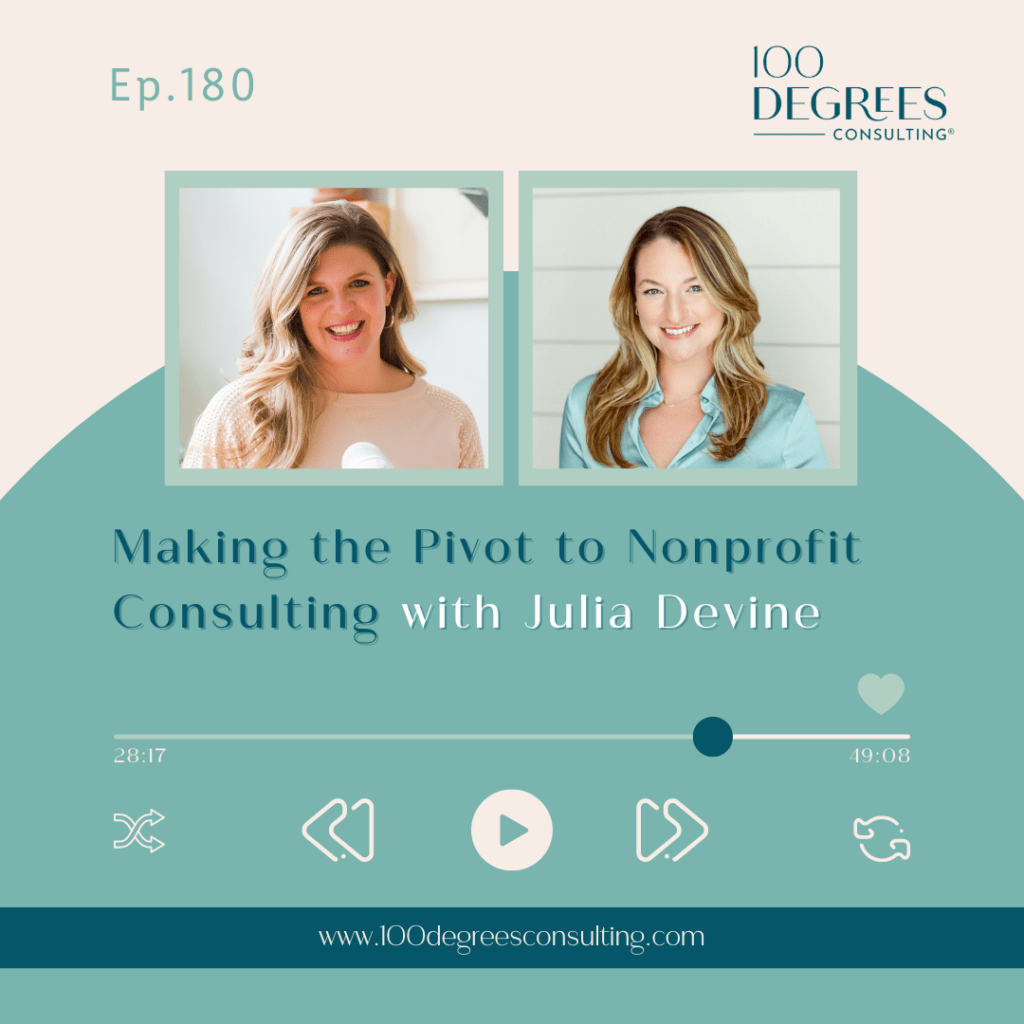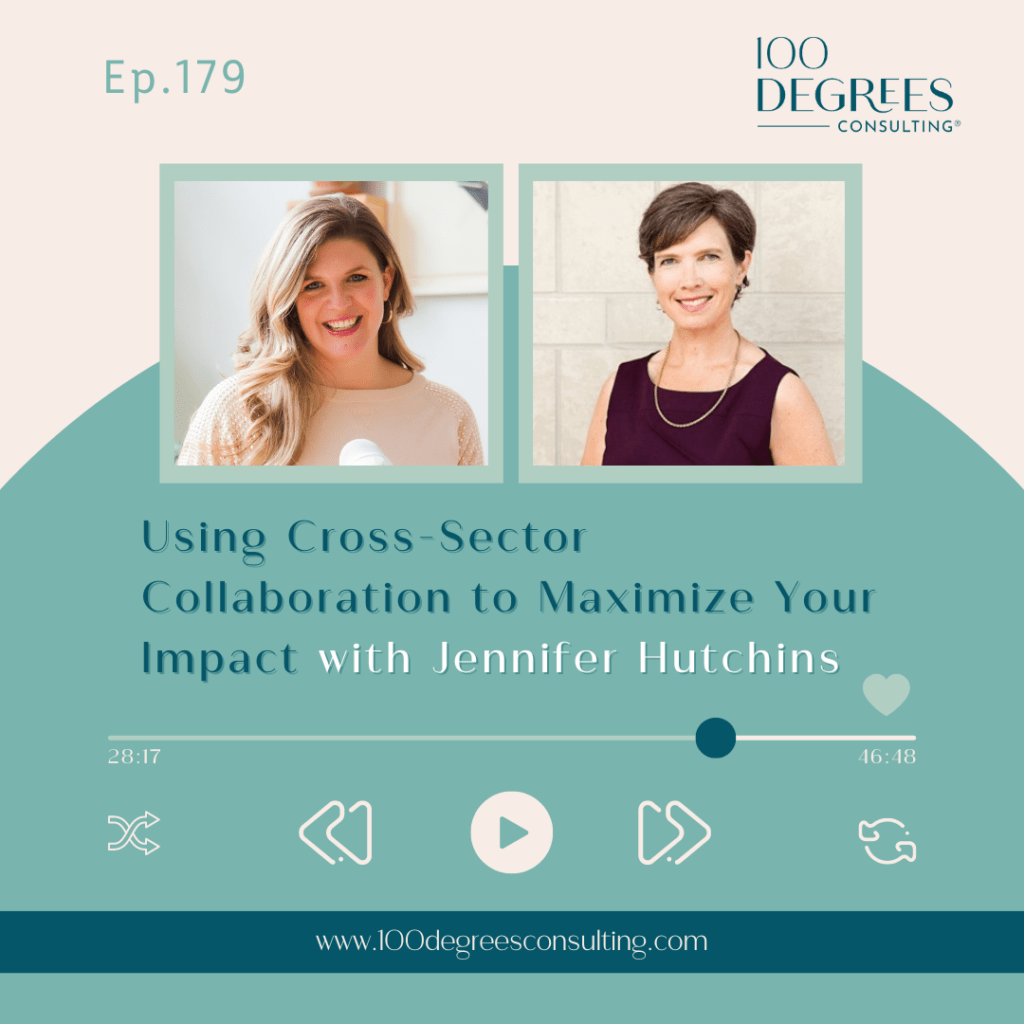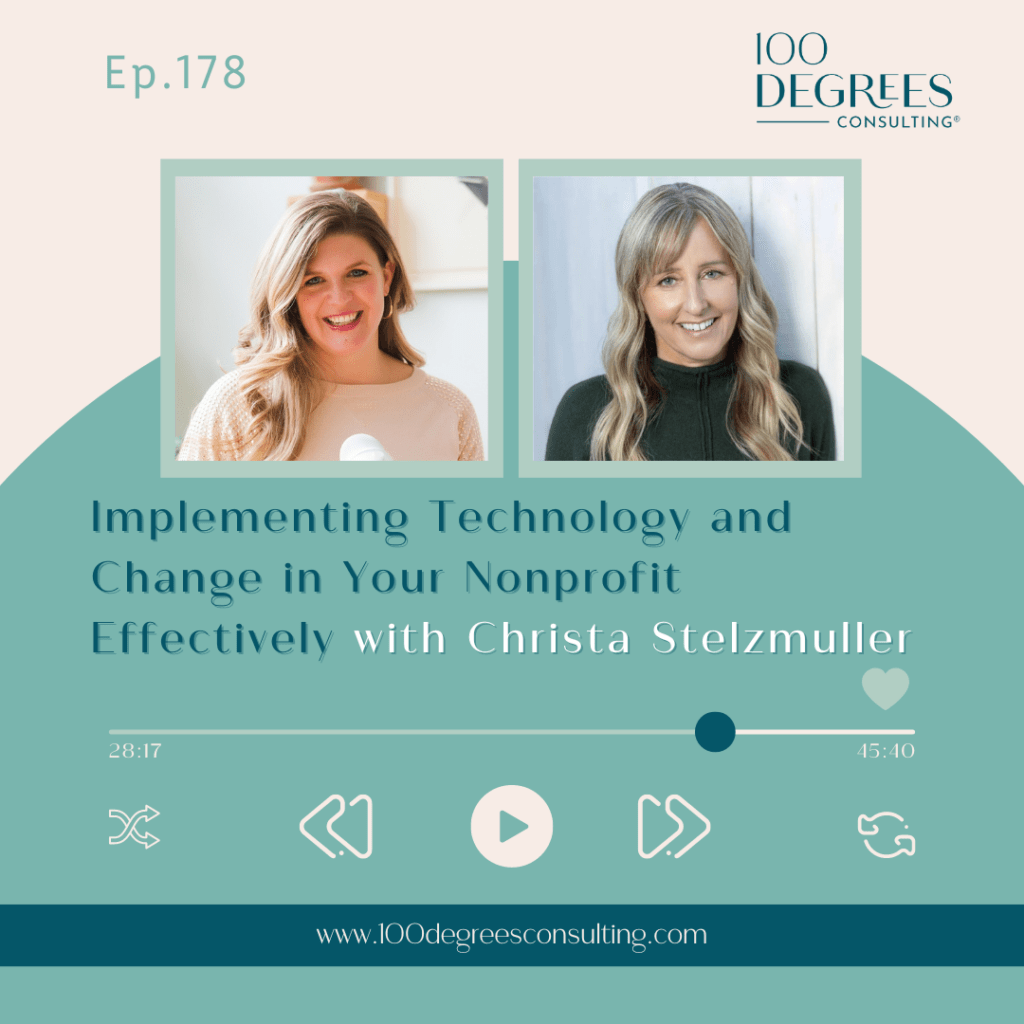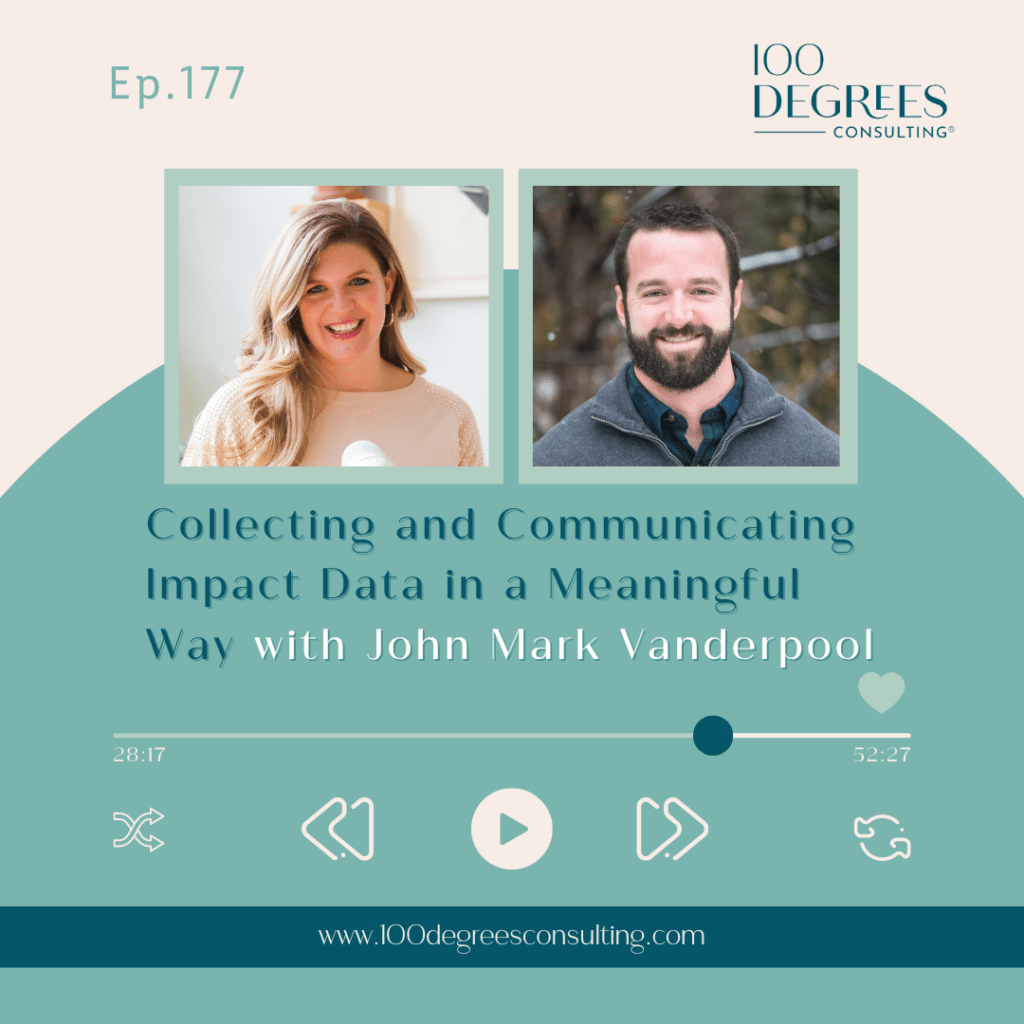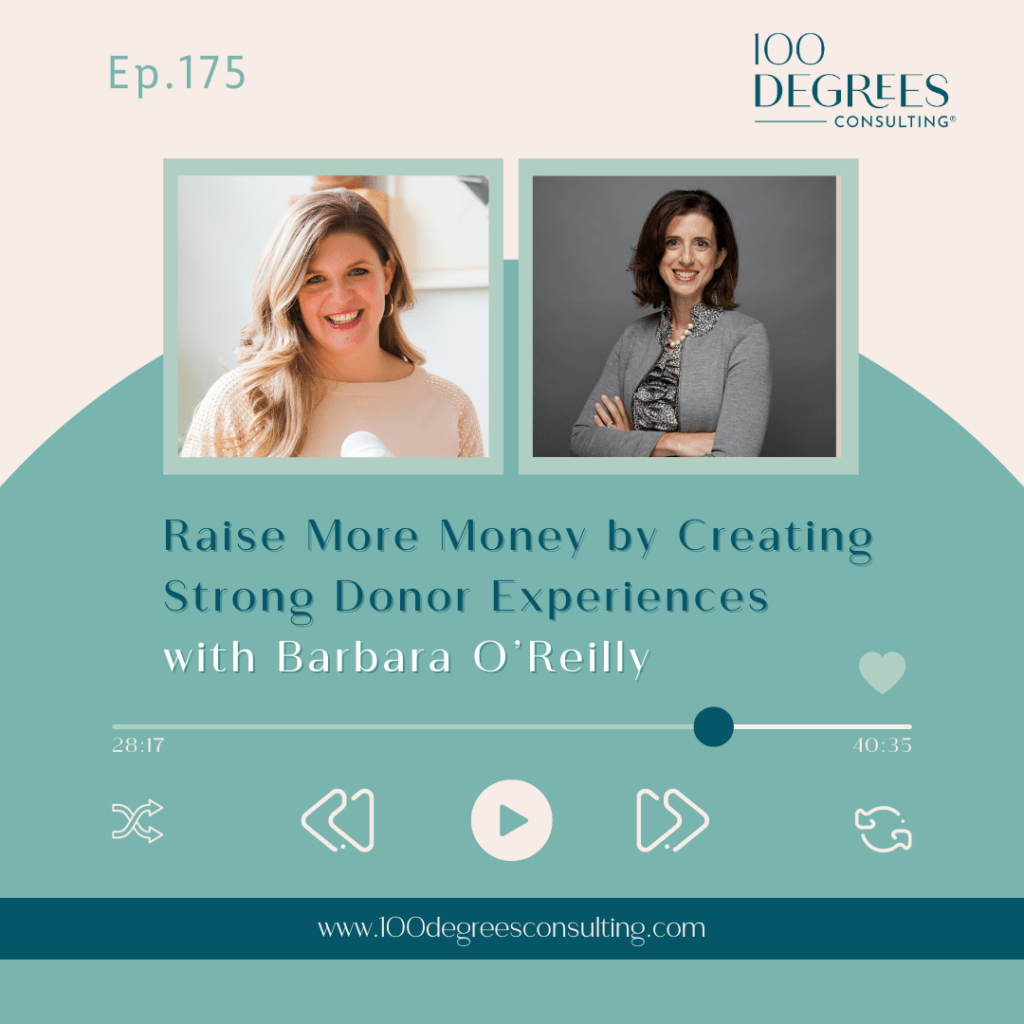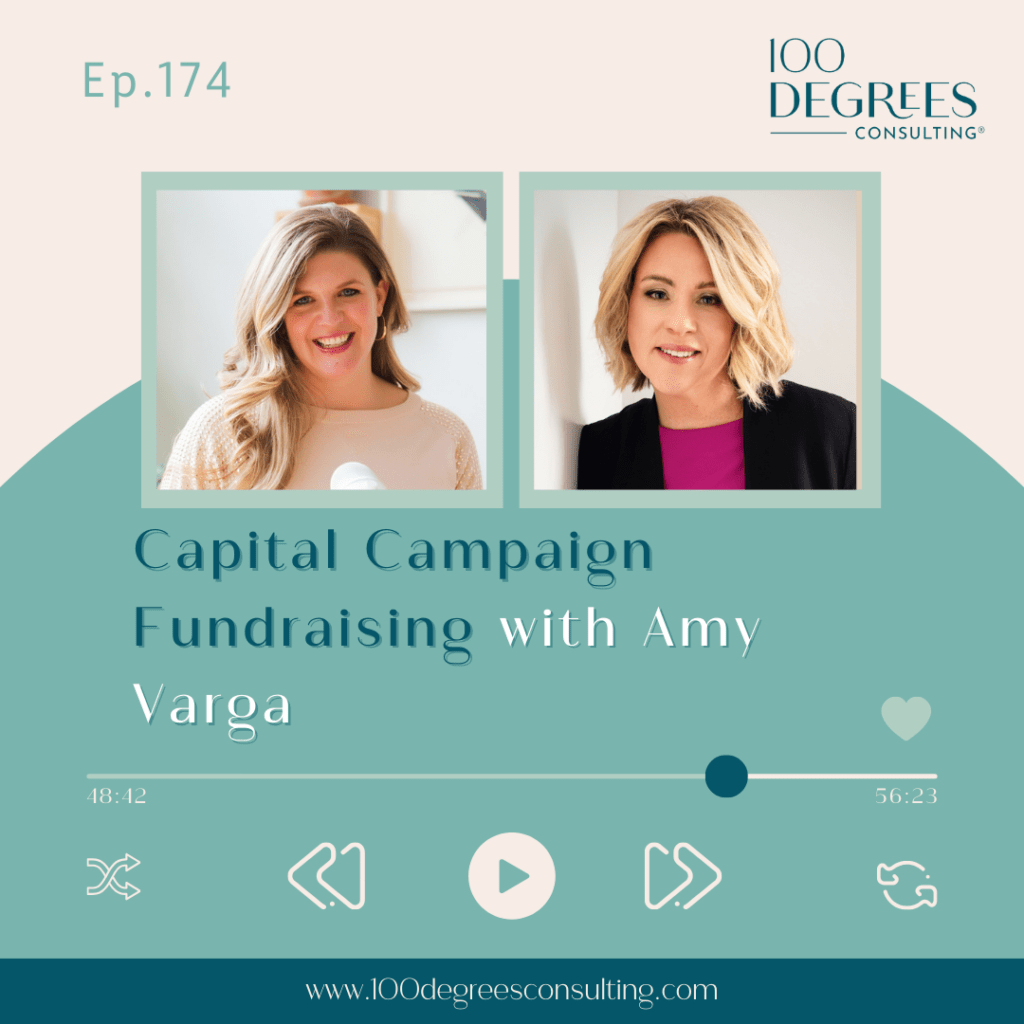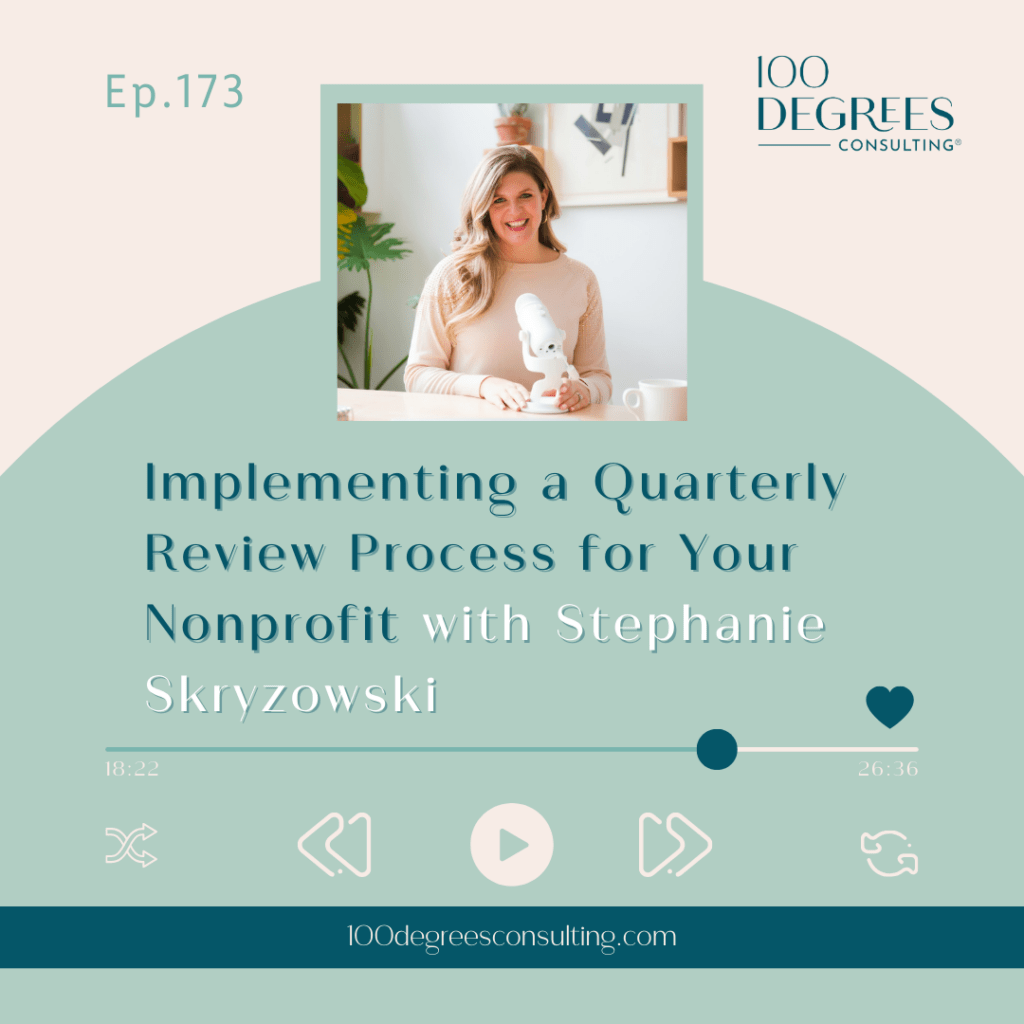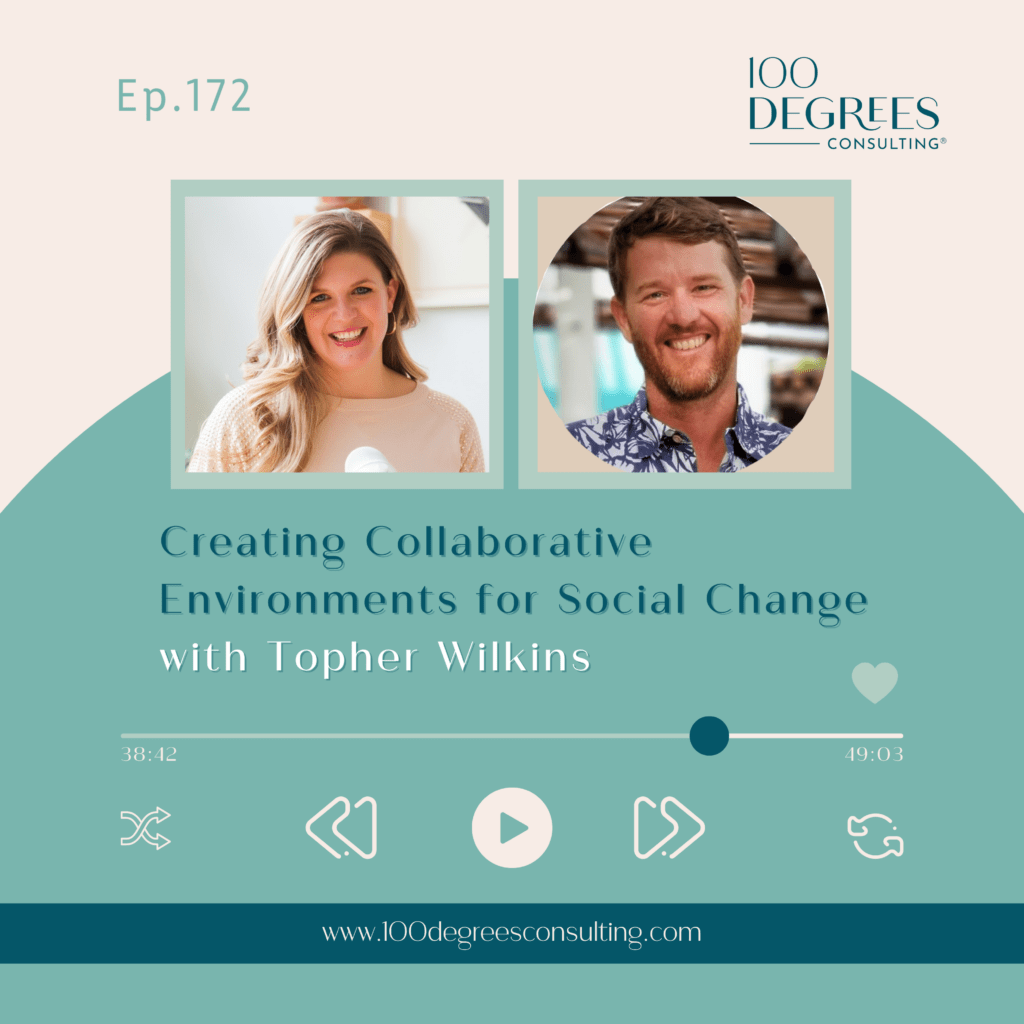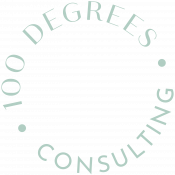Transcript Episode 124 – Proces Improvement: Why Change Isn’t Always a Bad Thing on The Prosperous Nonprofit
Stephanie Skryzowski: [00:00:00] Welcome to the prosperous nonprofit, the podcast for leaders who are building financially sustainable and impactful nonprofits and changing the world. I’m Stephanie Skryzowski, a Chief Financial Officer and founder, and CEO of 100 Degrees Consulting. My personal mission is to empower leaders to better understand their numbers, to grow their impact and their income.
On this show, we talk to people who are leading the nonprofit sector in new, innovative, disruptive, and entrepreneurial ways, creating organizations that fuel their lives, their hearts, and their communities. Let’s dive in.
Stephanie Skryzowski: Hello, welcome back to the prosperous nonprofit. Today I have Margaret Chapman on the show with me. Margaret has spent the last 20 years of her career helping organizations with their finance operations, fundraising, [00:01:00] and overall programmatic strategy. I. And Margaret actually used to work for 100 degrees, and so if you are a client of ours, you may know Margaret, you may have worked with her before.
She’s fantastic. And today we talk a lot about change management and breaking away from doing things the way we’ve always done them. And so you’re gonna get some really good takeaways on how to effectively manage change in your organization. We also talk a lot about sort of building a culture of improvement and of process review into your organization, which I think is so important to, again, just get away from like, this is how we’ve always done it, and really think about some new innovative ways to, to run things at your organization.
So, She’s super fun. Let me read you her bio and then we’ll get into it. So, like I said, she um, has spent the last 20 years of her career, um, working with national political [00:02:00] candidates and multi-billion dollar nonprofits to small startups, and she leverages what’s unique about each group. To ensure that they’re able to leap into the next phase of their growth.
Specifically, Margaret focuses on using strategic planning methods and building robust back office systems that fit the needs of the organization. Rethinking staffing, accounting and operational structures are her specialty. And side note for me, I can 100% attest to that. Throughout her career, Margaret has worked to make financial analysis processes and all things money approachable for all audiences.
Dealing with numbers is often anxiety producing, but Margaret translates finance speak into easily understandable concepts and practices that every organization can efficiently implement and feel confident in sharing. So as you can imagine, Margaret is like, you know, one of my people because that is one thing that’s super important to me too.
So let me read some of the organizations that she has worked for because it is super impressive. She was the VP of [00:03:00] Political CFOs and has worked with large nonprofits such as the Pew Charitable Trust and the George Washington University’s Cancer Institute. She’s also served as a principal at the Unfunded List and has consulted for Street Sense Media, American Alliance for Theater and Education and others.
She has her M B A as well as history and European and Eurasian Affairs from the George Washington University. She also has bachelor degrees in international affairs and economics from Marshall University, and she’s on the board of the national nonprofit Triage Cancer and has served a president of the board of the theater company, the St.
Mark’s players. So Margaret is a Jill of all trades. She has done a lot of different things and so I think her perspective working inside nonprofit organizations as well as a consultant for nonprofit organizations, it just makes her perspective really interesting on how to. Manage change. So without further ado, let’s get into our episode with Margaret.[00:04:00]
Hey everybody. Welcome back to the show and I am super excited to welcome Margaret Chapman to the show with me. Welcome Margaret.
Margaret Chapman: Thank you for having me. I’m super excited to be here. I
Stephanie Skryzowski: know we’ve known each other for a very long time now. I think we initially started working together in like. 2018?
Margaret Chapman: Yes.
Stephanie Skryzowski: Yeah. Oh my gosh. And I think we found each other. How did we find each other? Did you find me through Idealist? I think
Margaret Chapman: I did. Yeah. I submitted, um, to be one of the consultants CFOs. Um, and I, I joined the team, um, on a very part-time basis. I think I was doing one client at that time. Um, and then we had the Superfund retreat in Canada.
Stephanie Skryzowski: It was so random that was, I think, supposed to be in Buffalo, but then my Airbnb host canceled and so I was scrambling and I said, everybody, bring your passports. We’re, we’re going to Canada.
Margaret Chapman: I, I gotta think [00:05:00] I had your balls, my, my one and only time so far in life. So that was super fun.
Stephanie Skryzowski: Oh, that’s right. We did the Made of the Mist.
Oh my gosh. So fun. Okay, so everyone, yes, Margaret used to work with us at 100 Degrees Consulting and I feel like we bonded like pretty quickly because we both have this passion for nonprofit finance. Um, and so Margaret was just like a natural to join the team and we worked together for like four years, I think.
And I’m just so excited to talk to you today. So you have. Like, I always think of Margaret as, like, I always think of you as like you’re just always doing like 12 different things, like on the board of this organization and leading this organization and doing this work over here and like, um, and doing so like work in theater.
Like I feel like you’re always doing all the things. So I would love if you could just share, um, with our listeners kind of what your journey has looked like and then we’ll get into a little bit about what you’re doing now.
Margaret Chapman: Absolutely. Well, it has definitely been, um, a journey and [00:06:00] I actually was reading, a friend of mine on a, on LinkedIn the other day, mentioned that she was going through an identity crisis and that she didn’t like the word crisis.
She liked the idea of an identity quest. And so love that. Isn’t that fun? Um, so thank you for. And I think that’s been a lot of what I’ve done over the past, sadly say, 20 years of my career is really, it’s been a quest to figure out what I love doing, why I do what I do. Um, I started out in politics actually, and I spent, well, like seven or eight years working in the finance side of campaigns, state parties.
Um, I was often the person who got to tell everyone, no, you can’t do that. It.
Please don’t do that. Um, so that was, you know, that was a very, um, educational experience for those several years. I finally left after the 2000 [00:07:00] and, uh, 10 cycle election cycle and got more into the nonprofit side where I. I worked at Pew. Um, you guys probably know that Pew Research, uh, pew Charitable Trusts and really kind of honed some of the skills on the larger nonprofit side.
They are a, a huge nonprofit with several projects, um, after that, moving into the cancer space, working with the GW Cancer Center. And then over in the environmental space with Start International, they do capacity building, um, in Africa and Asia, in the climate change space. So it’s been a, a kind of a winding journey, but I think through all of it, it’s been, you know, how do I make things that seem scary, more approachable?
A lot like what you do, Stephanie, in terms of the financials, you know, is really. These ideas that seem overwhelming, like how do you make them not, um, overwhelming for an organization to really get their teeth in and understand and feel confident in with the work they’re doing. So I think that’s kind of been a play through a lot of it.[00:08:00]
Uh, on the side, I have worked a lot with various nonprofit boards. Um, I think my time on the Street Sense Board here in DC which you Google it, street Sense Media, they work with, um, the individuals experiencing homelessness in the DC area. Really kind of helped me to see, uh, that other side of nonprofits when I was at Pew.
And that’s a smaller group. The group that you know, doesn’t need a full-time C f O, um, doesn’t need a whole finance team, doesn’t have a whole back office. They have an executive director and a, an editor of the newspaper, and the rest of it’s run by volunteers. And so really kind of figuring out how do you work with that sort of nonprofit in the same way that you work with a pure gw.
So it’s.
Like where I am now, which is, you know, on, on a consultant basis with, um, one of my best friends, Jody Omar. We have our company Jam Strategies.
Stephanie Skryzowski: That’s awesome. It is Jam, Jody and Margaret.
Margaret Chapman: It’s, [00:09:00] it is indeed. Love it.
Stephanie Skryzowski: I love it because I love the like double meaning we’re gonna like jam out on like, strategy for your organization.
Is that, was that intended or was that just a happy.
Margaret Chapman: No, it’s definitely intended. Um, and we, as part of our process when we go through with nonprofits, we have a whole phase that we call a jam session. Um, it’s not just a delicious condiment that you can put on bread, um, that we do, we jam with you to really help your organization kind of reach that next level.
Stephanie Skryzowski: Do you send little like, gifts of jam to your clients at the beginning or the end of a project? ’cause if you don’t, you totally should. And you know, gif are my love language. I love giving gifts. So if you don’t send a little cute little box with like some fun artisan jams, you absolutely need to, um,
Margaret Chapman: Jody, make a note.
We will not be sending jams to people. Um, we did for a while. And stay tuned. Maybe it’ll come back. Post jam recipes on our [00:10:00] social media. Once a week, or you know, once every month or something. It was a, a new jam recipe that we thought people could try.
Stephanie Skryzowski: Okay. That’s so cute. And also, there’s a bar in Buffalo that, um, serves cocktails and their whole like shtick is that there’s like artisan jams, there’s like a cocktail with each artisan jam and they kind of like mix it up.
I forgot they ha they call it something. And my good friends Emily, who is probably is listening, Emily will tell, would, would know like what they call these cocktails anyway, it’s a cocktail and they like put mix in these jams and. So that could be another thing. Okay. We’re, we’re going down the rabbit.
Circling back. Um, okay. So I love that you reframed this, like what some might look at is like, wow, you’ve done like a lot of different things. Um, I love the connection that you made between all of them, and I love that you sort of reframed that or your friend did on LinkedIn instead of an identity crisis, an identity quest to [00:11:00] find what you love.
So do you feel like you’re at the point now where you have sort of identified that common thread of what you really love to do, and I’m assuming that’s what you’re doing now with Jam Strategies with Jody? Yeah,
Margaret Chapman: I think, I think we’re, we’re getting really close to it, right? Um, I think the, the main theme throughout all of it has really.
Ben trying to find a way to improve the lives of others. Right. And I think that’s what we’re working on now. There’s a Mahalia Jackson song If I can help somebody, that, uh, kind of has been a, a lifelong theme for me. And I think all of those pieces, up and down, in and out have, um, been ways to find what is the best way that I can help others and also, you know, make things better for that organization or for that person.
And I think, um, with Jam, we’re. We’re really honing in on what the things that we can do to help organizations help more people. Um, and I think that’s, you know, it’s so hard when you’re on the backend of an organization and a, and a program. You’re not on the front line. You [00:12:00] don’t, you’re not the doctor.
You’re not the one actually drilling the well, you’re not doing the things. So maybe you don’t get to see it, but how can you still feel like you’re having an impact? And I think that’s what we’re kind of doing at Jam Strategies right now.
Stephanie Skryzowski: Awesome. Are you an Enneagram seven? Have we talked about this before?
Margaret Chapman: Um, I think we have and I think it’s possible. I am. Um, I feel like there was also a three. I think it’s possible.
Stephanie Skryzowski: Yeah. I’m not an Enneagram expert. I’m a three and that’s the achiever. And so I could definitely see that. And the seven, I forgot what they’re like the whatever, but I know they like love to do all the things and I’m like, I totally see you as an Enneagram seven.
Anyway, so you’ve worked with a lot of organizations, which I think gives you like a very. Interesting perspective on like how organizations are doing things really well and also what are some of the common like challenges that we’re seeing in a lot of nonprofits right now. So let’s start with the latter.
What are some common challenges that you’re seeing [00:13:00] in nonprofits right now? And that could be anything from, you know, backend operations and finance to sort of broader, um, like sector-wide challenges, whatever. What are you, what are you seeing right now?
Margaret Chapman: Sure. And, um, one of the kind of stops along the quest that I didn’t mention as much is the Unfunded List, which is an organization.
I know you’ve worked with them, um, as one of our speakers. And also we worked with a hundred degrees for quite some years, um, as our CFOs. Uh, they provide, uh, philanthropy education for nonprofits and grant writers. We do grant review. And I think through that lens, it’s provided an a unique opportunity to see a kind of across a large swath of organizations, kind of what people are doing really well and what they’re kind of having some challenges on.
We do several symposia a year online that kind of talk about some of these challenges. For me, I think, uh, one of the things that comes up, um, especially in that fundraising space is the, um, the [00:14:00] issue of going for money for reasons other than you already have a program that needs funded. It is one of my soap boxes that I will talk about, you know, from here until next Thursday where, you know, there’s a grant out there, there’s a funding opportunity out there, and our organization fits, but our program doesn’t.
So we’re going to create. A new program because we want the funding. And I’ve seen so many times where organizations they did, they just want the money. And unfortunately they have to create something that now they, they get funded, leaves them in a, a terrible situation. Oftentimes they don’t have the staff to complete it.
They don’t have capacity on the backend. You know, they, they have the funding, but now they have to literally design an entire program, um, in order to make it happen. And I think that’s something with, you know, so many organizations going after so few resources right now is something that happens so often.
Um, they’re just, you know, everybody’s competing for the same dollars and so often it’s tempting to just go [00:15:00] after the easiest money that you can find. Um, so I think one of the responses to that, that, you know, we try to look at and we often counsel folks on, is to really start with your why. Why are we doing what we’re doing and what are the programs that we really want to focus on?
I think strategic planning is a lot more about what you’re not doing oftentimes than what you are doing, and so really having a good focus on understanding what you want to be achieving can help you say yes or no to those funding opportunities when they come up.
Stephanie Skryzowski: Hmm. Yeah. And I know that a lot of times the strategic plan is not as useful as perhaps it needs to be.
And so we’re going after these funding opportunities that are perhaps not aligned with our strategic plan. ’cause we don’t really have the strategic plan like front and center. You’re nodding. So do you see this a lot as well?
Margaret Chapman: I do. So [00:16:00] often you see a group that has what they, they believe to be a strategic plan and it might have some.
Foc focus areas they wanna work on. Like we are, we’re gonna increase our outreach by this, or we’re going to improve our programs by that. But that’s where it stops. And I think one of the pieces to really overlay onto any plan that you’re writing is a fundraising plan on top of it and a communications plan and operational plan so that it’s actually a tactical document.
It’s not something that, You. You spend months and months writing and it’s beautifully designed, and then you put it in a closet, right? And you bring it out every three years when you redo it. But that you actually write month by month operational tactics that you want to achieve to reach those plans.
And I think that will help some of the. The fundraising as well. ’cause if you know when you need to be looking for funds, what kind of funds you’re going after, you’ve done the research on the grants or the donors, the donor development, then you’re less, uh, tied to wanting to go [00:17:00] after those, those funds that require you to do things that you’re not comfortable with.
Stephanie Skryzowski: Hmm. Yeah. Yeah, you’re right. I think that’s so important. And I think that I like that sort of thread of adding in the operations and the fundraising, like tactics within that strategic plan. ’cause that’s gonna help you really assess, okay, is this the right decision for the organization or is this going outside of what we’ve already laid out as sort of our, our operational plan?
And do you see a lot of organizations, I know you work a lot on strategy and that is definitely one of your. One of your strong suits, kind of seeing the big picture and tying all the pieces together. Do you see a lot of organizations including finance things in their strategic plans? Or is that a missing piece that you see?
I mean, if we
Margaret Chapman: work with them, they do because it’s my favorite.
Stephanie Skryzowski: Yes,
Margaret Chapman: yes. Um, but it often is the missing piece. And I think, you know, there’s a lot of the programmatic side that gets included in terms of how we’re going to grow. [00:18:00] What we do, but so often it’s missing, um, how we grow, how we do it. So often missing is, you know, tho those great long-term financial projections or the month to month cash flows.
If we do this, then the cash flow looks like that. If we do that, it looks like this. The same thing with fundraising, like really doing the research and mapping out what those due dates are for various things, when you’re going to engage with donors over that one year period, um, how you’re gonna do it.
And then overlay the communication side. What types of social are we doing on top of this to make it all mill together? What is our messaging when we go after grants to make sure we’re all saying the same thing? How do we bring our board in so that the board is also engaged at all these levels? So I, I definitely think it’s something that, Again, because finances can be scary.
A lot of that, it seems very numbers ick. Um, but it’s something that if you’re, if you’re not including it, you’re really doing your [00:19:00] organization a disservice.
Stephanie Skryzowski: Mm-hmm. Yeah. Yeah. Absolutely. I agree. And I feel like, like I’ve watched organizations grow their programming and all of their, you know, all of their programs and expenses and staff related to their programming, like, You know, tenfold over a period of time, and they’ve still got the same finance team doing the same processes, with the same systems.
And that, um, you know, that sort of operational backend is just not, it’s not growing at the same rate. Um, and so that, Then things break. Things get things break. So yeah, so I love including that as part of the strategy because everything kind of has to move together. And I know I’ve seen in a lot of organizations, like very siloed, um, everyone’s kind of doing their own thing and, um, Yeah, there’s just not enough communication and not enough like, Hey, we’re all moving together towards the same goal here.
Let’s work together. [00:20:00] Um, have you seen any examples of organizations that do a really good job at collaboration, at breaking down those silos so that everyone really is moving together? Yeah.
Margaret Chapman: Oh, um, hmm. That’s a good question. Uh, examples of.
Stephanie Skryzowski: Or the opposite, or organization. You don’t have to, you don’t have to identify who they are, but if there’s any ones that you’ve seen that are like, super problematic.
You know, either way, I, I do
Margaret Chapman: think that there are some that I’ve worked with where, um, the program is just like you’ve said, 10 years ahead, they are, you know, outpacing everything else. But no one has any idea the stuff that’s going out and press releases are on social. It’s not matching what the program is doing.
You know, the grant, uh, proposals that are going out are not matching what is actually taking place on the programmatic side. Um, you have finance people who, you know, have been doing this, like you said, the same thing for the past 10 years. They have the same [00:21:00] reports, the same infrastructure. Um, They don’t communicate at all with the other folks in the office.
And, you know, I did work for one organization where, um, as the finance person, I sat in on every pro big program meeting because it helped me to do my job. I’m a better finance person. I can manage your budget better, I can make sure everything’s coded correctly, and I can help forecast what you’re going to need if I’m sitting in that meeting with that program person.
And hearing, oh, we’re, we’re gonna be expanding this. We need to bring in two new staff over here. Um, you know, we’re gonna be doing these things. I, I can do my job better. The communications person can do their job better. If they’re in that meeting and they hear that, oh, six months from now, we’re probably gonna have to announce we’re hiring new staff, or that we’ve expanded this program.
Like, if they’re all in the same space, even if it’s a virtual space, um, just. Getting them all on the same page, even if it’s just a regular check-in once a month, [00:22:00] um, to make sure that everyone kind of knows what the other pieces are doing. Because when it doesn’t, then you do have people kind of just going their own direction.
And you know, especially, again, finance folks, we’re just doing the day-to-day half the stuff. I may, I may code incorrectly because I don’t know that that’s the program that’s dealing with the food market versus the kitchen. Right. I’m just coding stuff the way it’s always been done. I don’t know that we’ve grown the food market a hundred percent over the past year.
No one’s really told me. I just know we’re buying more food. Well, all right. I’m gonna do my same 60 40 split over here. You know, kitchen is the market. But if I’m brought in, then I know that actually it’s, we need to readjust that split. You know, we need to readjust some of the ways we’re thinking about things.
Stephanie Skryzowski: Yeah, context is so important and I love the idea of sitting in on, on meetings that are not necessarily like your department, but really being able to kind of understand the bigger picture of what’s going on.[00:23:00]
Have you been spinning your wheels trying to figure out how some nonprofits have three or six months of a cash reserve? While you’re barely scraping by to make payroll every two weeks, I’d venture to guess that one of the reasons you feel overwhelmed and nervous about your cash situation is because you don’t have a forecast.
So I’ve created a free cash forecast template for you. This spreadsheet will help you forecast your cash flow, build an insightful budget, and really help you see into the future of your revenue and expenses. I’ve built the template for you now. All you have to do is use it, gain more clarity into your numbers so you can make smart decisions today.
To grow your impact and income tomorrow. Head over to 100 degrees consulting.com/cash to get your free spreadsheet.
You know, a lot of what you talked about is sort of like, this is how we’ve always done it. I just feel like that is, [00:24:00] that’s rampant in the sector and that’s not everybody by any means, but I just hear that so much. Or, you know, we start working with a new organization and it’s like, okay, tell us about, you know, your system for.
Paying bills, for example, something so simple and straightforward that every organization, we all have bills to pay. And I remember talking to this one organization and I, I actually don’t remember who it was, so if you’re listening, I’m not even intentionally calling you out ’cause I don’t remember who it was.
But they had to, literally somebody at the organization had to literally print checks out on a piece of paper, get in their car and drive them across the city. You may actually know who I’m talking about, Mar, I feel like it was the shared client. Drive. The drive. We will not identify them, but drive them across the city to have a board member sign them like.
I’m not sure that we could get any more inefficient than that. Like having someone physically drive checks across the city for a signature. No, but that’s the way that they had always done it. And so nobody [00:25:00] really even questioned like, does this make sense? Um, because the process just inherited time and again, so I’m sure you’ve seen that like a million times over as well, and.
Yeah, I guess like what are you seeing? You know, we talked about organizations that are, you know, maybe not doing things so great. What are you seeing in terms of organizations that are approaching things like that kind of, this is the way we’ve always done it, but with a fresh look in a new and innovative way.
What creative ideas or solutions or whatever are you seeing out there? Yeah, and
Margaret Chapman: I think, um, you know, there are some covid has, you know, for better or worse, changed the way we do a lot of things. And for some organizations it’s actually been an opportunity for them to retake a stock of what they’re doing, how they’re doing it, and maybe how they could do it better.
So that organization that had to drive their checks across town know if you’re in the middle of a pandemic, that’s not always a [00:26:00] thing you can do. You can’t just drive your car, your checks across town. So how do we improve these systems so that we can adapt, um, to the changing times. A lot of the groups we work with at JM are in a transition state.
That time they come, ’cause they have a new executive director, they have new board leadership and that is a great time to introduce new processes, new policies, to really take a, a hard look at what you’re doing well and where you can improve. But not every group has that, you know, as a transition point in this moment.
So I think right now the couple of the groups we’ve worked with is, There is such a hard thing to look at and figure out how can we do things better Because we’re all people, we are very comfortable in the way we do things. Change is hard, even if it’s a change that we know will probably improve our lives and our ability to do our work.
It’s still new and scary in the moment and so a lot of what I’ve seen folks do is really engaging staff at all [00:27:00] the levels. Right. It’s not coming in at the top and saying, you know what? We’re gonna redo the way we do bills. We’re gonna institute a whole new QuickBooks chart of accounts and revamp our entire payroll system and, um, change how everyone does everything tomorrow.
It’s really talking to everyone on the team and figuring out. What is working for you? You know, what isn’t working for you and we’re not gonna change everything overnight, but what are the one or two things that are causing a slowdown in the way we do things And that we can tweak now and we’ll tweak one or two now, and then in a few months we’ll tweak one or two more.
Um, and I think a lot of what we’re seeing, especially during this time of transition for everyone figuring things out, is just having to be open to ideas from all levels. It’s not. Something that someone comes in from outside and says, do it all this way. It’s really engaging the people who are having to do it every day and saying, [00:28:00] what are your ideas for how to do this better?
You’re the one who has to sit there and write that check, so, What is what? What ideas do you have? We may not be able to institute all of them. Maybe there are some best practices that we wanna make sure we incorporate, but as we do that, there are as many ways to do something as there are organizations and people.
So we may say, we know we wanna have an online bill pay system, but which is the right one for this organization? Well, I want you, the person who’s writing the checks to sit down with me and we’re gonna walk through it and see which one fits you and this organization best. What does that rollout process look like?
Do we need a new s o p? Do we need, you know, different authorities? Like what are all those pieces and really engaging. Everyone from the ground up in that decision making process so that it’s not a jolt. And you’d be surprised by the different ideas that come up when you do that. People have been sitting on ideas for ages, is what I’ve learned.
That they’re doing things the same way because that’s what someone taught them 10 years ago when they [00:29:00] started. But they’ve been thinking about better ways to do it ever since. But no one’s actually asked them. Hmm. So it’s just ask and then, and again, not everything could be done that everyone wants, but um, when you hear people and try to incorporate what they’ve been thinking for all that time, um, not only do I think you get a better product that’s organization and person focused, but it’s going to be more sustainable.
Uh, it’s not something top down. It is something that someone can live with and work with down the road.
Stephanie Skryzowski: I love that idea of empowering the team who, you know, maybe they have not felt empowered to date because their title is more junior or they, they just don’t feel like they have the ability to, um, to share.
But I love that I. Do you have an example of somebody that you’ve seen sort of like, you know, sort of shine their light through this process and be able to bring something to the table that, um, and, you know, [00:30:00] and improve something in the organization?
Margaret Chapman: I do. I won’t mention the organization’s name, um, of course, but that’s fine.
Jody and I have worked with in the past and the individual, you know, every time we would bring up wanting to change something, It was always, oh, they won’t go for it. They won’t go for it. We don’t, you know, we, we can’t even mention that as a, as a change. We wanna make. But then we sat down and said, well, what are your thoughts?
You know, we see this as an issue. It’s holding up a larger process. Um, we need to do something. And they just had all of these ideas, um, that they had been sitting on. They had ideas for how to do payroll better. They wanted to switch over to an online QuickBooks account. They were like, I’ve been investigating CRMs and bill pay systems for a couple years, but I, I never had anyone to tell.
So here’s what I think would be best for us. And we haven’t made all the changes yet, but we’re, you know, in the process of, of thinking through them and, um, not only are they doing their job more, they’re [00:31:00] happy or in their job, they’re more engaged with the team. But I can also say that when we do make the changes, they’re going to step into that role and actually make sure that everyone follows through on what these new systems are, um, that they’ve taken ownership, they’re excited about it.
Um, but it, yeah, it’s, it’s actually amazing to see everyone was so scared to even bring these things up and then once you do, it’s like, you know, I mean, it might not work that way every time, obviously, but. I do think that people have ideas and they’re always, you know, often so scared to share them. Um, but once you change the way we do this, um, please let me, I want to take this on.
Stephanie Skryzowski: Yeah. I love that. I think that’s a great example, and I love that the idea of empowering people, this collaborative approach and thinking about doing it step by step. Like nobody has to come in, whether it’s, you know, an outside person or the executive director and change [00:32:00] everything up like. All the things all at the same time.
I love the idea of kind of doing this step-by-step and bringing people along with you. I really like the idea that like the most innovative ideas really come from within the organization. ’cause I guess at that, you know, at the end of the day, They know the organization best ends the day to day. And it’s not necessarily, I feel like, you know, myself and my business, I can often get that shiny object syndrome where I’m looking at other companies, um, following on social media, like doing this cool thing, or, you know, I find this, you know, new webinar about, okay, this is the way that you should do your marketing, whatever.
I’m like, oh, let me go do that. But really the best ideas and probably the most impactful ideas are going to come from within versus. Getting distracted by all the things everybody else is doing,
Margaret Chapman: especially the ideas that are the best fit for your organization. Because yeah, it may be a shiny idea and it, you know, executive directors especially will see all of [00:33:00] the the things, I wanna try that, I wanna try that.
But the people doing it day to day will know, is this gonna work for us? You know, yes, that’s a great idea. And that may work for, it may work for Pew, it may work for this other organization, but will it work for us and the way we do things? So, you know, really trusting the people that you’ve brought on board and listening to them.
Hmm.
Stephanie Skryzowski: Yes. Yeah, I really like that. It really is so much about trust and you brought these people into the organization for a reason and so let’s trust their ideas. And I’ve been part of organizations that do this really well and do like, come to me and say, Hey, we we’re thinking about this. What do you think about it?
Can you help us, um, you know, work towards a solution and implement? And I’ve also been part of organizations that like, Don’t listen to anything you say and continue to like, do things their way even though you’re the expert in your area. And so we’ve definitely been part of both of those. And the second, the first one feels [00:34:00] like way more empowering, um, when your leaders trust you.
So I love that you
Margaret Chapman: definitely run the, um, the first one. So I will say, you know, from being the other side, you definitely trust your team, um, and love hearing ideas from them. So I always appreciated that about working with Stephanie. It was environment to share our thoughts, even if it was like a crazy thought, a crazy idea for something.
Um,
Stephanie Skryzowski: those are my favorite ones though, because I feel like those are the ones that turn into really cool, like innovative, disruptive type things. And that’s all that we, that’s like what we like talk about on this show. And so I think that’s a very good point. And not to like, Not to toot my own horn in the way that I run my company by any means, but I really do as a leader, I do like hearing those crazy ideas because that is what, that’s what’s disruptive and innovative, and that’s what gets us away from like, I.
Doing things the way we’ve always done them, which I, I don’t love. Um, but you know, on the flip side, that’s really interesting because [00:35:00] sometimes I was just talking to Danielle this morning, um, about this podcast and we have done, um, With a hundred degrees of entrepreneurship, we did a hundred episodes.
And that’s a lot like, that’s a lot of episodes. And we have built out, I say we, Danielle had built out a whole process for producing this podcast. And so when we kind of switch gears and are now running the prosperous nonprofit podcast, I used it as an opportunity to, um, look at the process and say like, okay, is there.
A way that we can or should like disrupt this. Can we do this better? Can we innovate? And I reviewed the process and I was like, actually no. Like it’s pretty good as it is. So props to Danielle. But I think that my point is just like I. This is how we’ve always done it is not always a bad thing. I think the key is to like continuously review and continuously [00:36:00] think about is there a way that we could iterate and make this better, or is this process working really well?
And so it’s not. Change for the sake of change. Like we don’t always need to be changing things around. So
Margaret Chapman: I think it’s fun because, um, I mentioned Unfunded List and Dave Moss who runs that will often joke that he started a nonprofit just so he could do that exact thing. ’cause he wanted to run a process audit, um, and figure out how to do things better every time.
And that’s one of the things that I always appreciated about that organization as well, is that every six months after each round of, uh, grant review, We have an entire process audit. We go through to figure out what went well during the process, what emails went out that did well, how can we communicate better?
What is our tech stack? Um, can we improve the tech stack next round? What changes do we need to make? I. Every time because there was always some sort of feedback that we got from evaluators or from folks who had submitted to us, uh, with, you know, oh, I would [00:37:00] love to see you guys try this, or, I would love to see you try that.
And so we would all take that in, go through, figure out how we could do it better. And then, you know, unveil the next round. But that was always something I loved about that process was, you know, figuring out and some things where you’re right, we’re great and we’re like, you know what? We actually did this really well this time.
Um, we don’t need to change it, but there may be something else in that process. We do wanna change. Hmm.
Stephanie Skryzowski: What I’m hearing is like you built a culture of review and improvement, and I love that you built that into the routine because I feel like oftentimes we’re only looking at things with that lens when something’s broken and we’re like, okay, I can’t take this anymore, or would like something, you know, disastrous happens.
Um, so I love that you sort of built this culture of like, We’re gonna continuously refine and assess and improve and review. And I feel like that’s a really great takeaway for our listeners [00:38:00] because I feel like sometimes we’re not really looking at things until they’re broken or until, you know, somebody in the organization unexpectedly leaves and now we have to look at this process again and whatever.
So I like that. Um, I like the idea of sort of building it into building the review into your process. That’s part
Margaret Chapman: of awesome strategic plan, and we think through the operational plan, we’d always build those in because you know, you wanna be able to, and Aaron calls it, you know, monitoring and evaluation.
It’s all kinds of fancy ideas and processes behind it. But at the end of the day, it’s just really, what are we doing well? Where can we do better? And let’s figure out where we go from here.
Stephanie Skryzowski: Yes. I love that. I love the way that you just simplified that too, because sometimes it’s like, oh, well now we need to hire a consultant to do a review or to like build out a process for the review process.
And actually like, it doesn’t have to be that difficult, like, oh well, well what didn’t go so well, and like, what’s the way forward? I like how you simplified that. Amazing. Okay, Margaret, [00:39:00] I always love to ask the question before we wrap up. What does a prosperous nonprofit look like to you?
Margaret Chapman: For me, a prosperous nonprofit is really focused on their why and engaging their community, um, at all levels of the work that they do. And they’re really living out kind of their own, um, best practices. So, so often nonprofits are just, you know, we hear all about the burnout of staff and all of these different pieces that.
Really the nonprofit is living out, its, um, its own best practices with its staff, with its community, with the people it serves. Um, and that it’s able to do all of those things in a way that, um, you know, does not stress resources including its team, um, and its financials. Mm-hmm. Um, that offers a great, uh, benefit to the community.
Stephanie Skryzowski: I love [00:40:00] the way that you phrased that, kind of like living out its own mission because you’re right, we’re doing this like incredible work at the community and our staff is often underpaid and overworked and. Frankly, quite miserable a lot of the times. Mm-hmm. Um, but like just pushed on by the mission.
And so I love that a prosperous nonprofit is sort of living out its mission internally, externally. Beautiful. I love that so much. Okay. Tell us where we can find you, um, where we can learn about jam strategies and where, where we can find you.
Margaret Chapman: Oh, we are@jamstrategies.com and we would, you know, love to hear from anybody who has, um, ideas on strategic planning and nonprofits.
Um, we’re also on Facebook and Instagram. Um, so. Follow us there for maybe some potential new jam recipes or cocktails that use jam, I dunno. [00:41:00]
Stephanie Skryzowski: But also things like communication, the financial strategy and organizational effectiveness, all that good stuff too. All that important stuff. Plus the jam. Awesome.
Well, Margaret, thank you so much. I’m so glad we got to chat and catch up and everybody check out jam strategies.com and learn more about Margaret. So thank you so much, Margaret.
Margaret Chapman: Thanks for having me. This was super fun.
Stephanie Skryzowski: Before you go, I just wanna thank you for being here. To access our show notes and bonus content, visit 100 degrees podcast.com.
That’s 100 degrees podcast.com, and I’ll see you next time.


